At first glance, psychographics doesn’t seem like a marketing term. After all, it shares a dictionary page with psychosis (losing touch with reality), psychosomatic (physical problems caused by mental problems), and plain old psycho.
But even if psychographics is in odd linguistic company, it is still something that every marketer should understand. This post will take a closer look at:
- What psychographics is, and why it’s different than other types of data.
- How it’s data can be used by marketers.
- The process for how it’s data is collected.
- How you can outsource that data collection to our all-knowing friends at Facebook and Google.
- And how to implement and maximize psychographic segmentation.
If you stick around for the next six minutes, you’ll understand exactly what psychographics is, and how anyone with something to market – like, say, an ecommerce store – can use it to their advantage.
Post Contents
- What Is Psychographics?
- Psychographics vs Demographics?
- The Different Types of Psychographics Audiences?
- What Are Examples of Psychographics?
- What Is Psychographics In Marketing?
- How Do You Use Psychographics?
- How Can You Gather Psychographic Data?
- Want More Psychographic Data? Facebook and Google Got You Covered
- Implementing Psychographic Segmentation
- Conclusions on Psychographics
- Want to Learn More?



What Is Psychographics?
Psychographics refers to people’s qualitative characteristics. Psychographics focuses on opinions, behaviors, and attitudes. You know, the softer stuff that’s harder to wedge into a data set.
Psychographics is nothing new. It popped up in the 1970s, and its power to help marketers has been apparent from the get-go.
→ Click Here to Launch Your Online Business with Shopify
In 1975, Journal of Marketing Research published a paper titled, Psychographics: A Critical Review. In the paper, advertising expert William D. Wells breaks down what this emerging field of psychographics is all about:
All psychographic researchers have attempted to move beyond demographics… [and] have embraced a wide range of content, including activities, interests, opinions, needs, values, attitudes, and personality traits.
Psychographics, however, is not just a bunch of flowery questionnaire responses. The goal is to accumulate reliable, quantifiable data. Wells, for example, talks about using “cross-tabulation and multiple regression” to unearth information and execute psychographic segmentation.
So all that vocab you learned in Stats class is alive and well in psychographics.
Psychographics vs Demographics?
There are vast differences between psychographics and demographics. Demographics analyzes quantitative traits like age, gender, income and relationship status to determine the different categories within a population. Psychographics looks at harder to qualify traits like opinions, attitudes and lifestyle which can change as people age or move up in their careers.
It’s been said that demographic data helps you understand who purchases your product or service, while psychographic data enables you to understand why they purchase. For example, if two 20-year old students with the same level of income eat KFC twice a week, you can say that students are one of KFC’s target consumers. However, without knowing why they eat KFC twice a week, it may be hard to come up with a killer marketing strategy. This is the gap psychographics effectively fill – answering why people buy based on their values, beliefs, interests, and opinions.
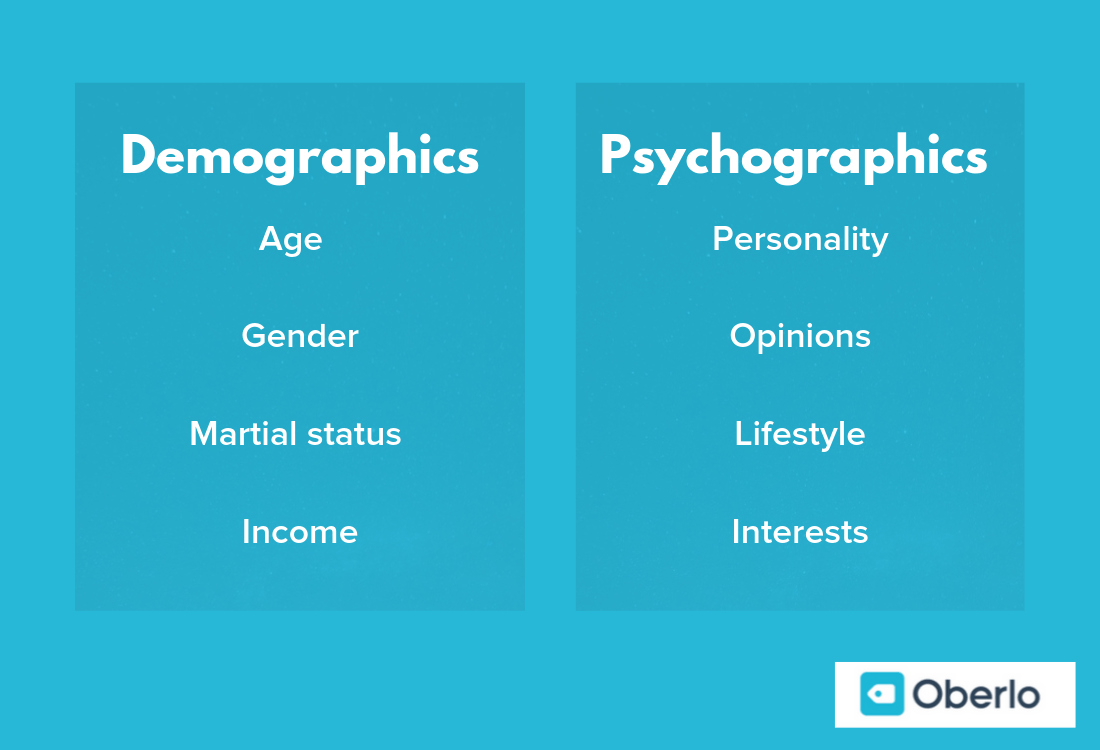
Common demographic groups include Generation X, which is the generation born between 1960’s to 1970’s, or a millennial, who reached adulthood in the early 21st century. Psychographics can be difficult to breakdown into groups but can include those who believe strongly in a certain societal movement, like Greenpeace, or members of a particular social class, like the upper class.
The Different Types of Psychographics Audiences?
Psychographic audiences cover a whole host of different behaviors that can help identify why customers like particular things. This can help you understand how to sell, upsell and cross-sell to customers easily. It is important to spend time learning about what these different behaviors mean for different customers so as not to annoy customers or bombard customers with the information they are not interested in.
The below different types, or factors, of psychographics help to identify customers who are interested in learning more about your company, those who are uninterested in your company, and those who will become influencers if given the right information. These psychographics are:
-
Lifestyle
Our different lifestyles help to shape our wants and needs. Lifestyle patterns exist that position people at similar stages in their lives that can be linked to their interest in products or services more than other groups of people. When carrying out psychographic marketing, it is important to position your product or service as a solution to an issue your audience is facing.
-
Social Class
Some people can have very strong personality traits that shape how they buy products or view companies. Due to this strong affinity to a trait, your brand must mirror it in order to get these types of individuals interested in buying from you. An example of this type of psychographic is of those who are staunchly against animal testing. For this psychographic audience to be interested in buying a cosmetic product, it must not have been tested on animals or be linked to animal cruelty in order for it to adhere to this standard. Brands must ensure that, whatever traits their products represent, they aren’t sacrificing them or they will lose their following and earn themselves negative press.
-
Personality
Some people can have very strong personality traits that shape how they buy products or view companies. Due to this strong affinity to a trait, your brand must mirror it in order for these types of people to be interested in buying from you. An example of this type of psychographic is of those who are staunchly against animal testing. For this psychographic audience to be interested in buying a cosmetic product it must not have been tested on animals or be linked to animal cruelty in order for it to adhere to this standard. Brands must ensure that whatever traits their products represent they must not sacrifice them or they will lose their following and earn themselves negative press.
-
Activity, Interest, and Opinion (or AIO for short)
This is the most important type of psychographics audience as it encapsulates the political views that we hold, our opinions on gender, our interest in issues like the environment, and the activities we undertake to let our feelings be known. The value of this type of psychographics was front and center in the media due to the Cambridge Analytica Scandal in 2016. Even though this case study shows the unethical use of information, there are many ethical ways of using this type of information to target customers effectively through marketing.
Equipped with the above information and the means to collect it, you can build a great psychographic marketing campaign to increase sales, engagement, or customer loyalty.
What Are Examples of Psychographics?
Psychographics can be the difference between a great rebrand or one that falls short in terms of customer satisfaction. Dropbox, for example carried out a lot of research before their 2017 rebrand and also directly afterward to track the immediate results of conversions from the rebrand. Its new brand focused on “unleashing creative energy” while promoting a clean UX, hinting at targeting companies who are young, trendy and focused around the cloud and data.

Without the help of customer feedback and understanding their main audience from more than a demographic perspective, Dropbox would not have been able to create a brand that represents the majority of customers who do business with them: trusting, organized, and tech-savvy people and businesses who are looking for ways to get some time back in their day.
Another example is of the luxury car brand Porsche. Porsche’s “Engineered for Magic. Everyday” campaign was launched on the basis of the company’s interest in marketing to the psychographic profile of people who desired a sporty vehicle for daily use.
Porsche USA’s CEO, Michael Bartsch, revealed that it made the company reimagine the visuals used in existing marketing campaigns. Ads were changed from saying consumers need a long winding road to drive a Porsche to focus on everyday driving. For instance, part of the new campaign displayed a yellow Porsche 911 parked outside of a school building with text that said “School bus.”

The result? Porsche saw a 35% increase in 911 vehicle sales in the first two months of the campaign. Even today, the “everyday use” is still a popular theme with websites like porscheeveryday.com offering practical information and advice on how to use a Porsche as an everyday car.
What Is Psychographics In Marketing?
Psychographics in marketing is using the information gathered on people to push marketing collateral that is of interest to them. Highly targeted marketing campaigns that speak directly to customers wants, needs and beliefs can increase your conversion rate by up to 40 percent. Now that marketing has become smarter and customers are more clued in on what they want, it is important to know what your customer intent is and what type of information they want to receive without them explicitly asking for it.
Psychographics audiences could be used to identify what stage of the funnel a potential customer falls into, which products might be the most interesting to a website visitor, or inform marketing on what other products could be sold to a customer. The possibilities are endless with psychographic, as long as the information gathered is accurate and trustworthy.
How Do You Use Psychographics?
As far as marketing goes, the goal of psychographics is to deliver more impactful campaigns by understanding customers better. In other words, psychographics is supposed to shed light on what will best convert target audiences.
Wells uses the Ford Pinto as an example of psychographics in action. Not familiar with the Ford Pinto? Here is a picture of one. (The waitress on roller skates gives us further context for just how long psychographics has been around.)

Wells explains that Ford’s original advertising plan for the Pinto centered on the car being “carefree and romantic.” Psychographic research, however, showed that prospective Printo customers didn’t have a romantic oriented towards driving and vehicles. They backed claims like “I am more practical in my car selection,” “I wish I could depend on my car more,” “The only function of a car is transportation…” “A car offers me a chance to tinker with machinery.”
This psychographic data inspired some repositioning. Ford’s advertising for the Pinto evolved accordingly, presenting it as a practical, economical vehicle.


This psychographic-driven change helped the Pinto become a huge success.
How Can You Gather Psychographic Data?
- Conduct Surveys
Surveying your customers is a great way to discover psychographics. Creating surveys via tools like SurveyMonkey will help you understand target audiences better. Ask close-ended questions like “which of these three features do you like most in our product? A, B or C?” to get precise and meaningful insights into your customers’ preferences.
- Interview Your Customers
Have a conversation with some of your favorite customers, and ask questions that enable you to dig deep into your psychographics. If you’re a brand new company with no customers, speak to individuals who have similar demographics as your target audience.
- Speak to Your Customer Service Team
Got a customer service team or a virtual assistant who answers product-related queries on your behalf? Talk to them. We recommend doing this because they interact with your customers on a day-to-day basis. Ask them to share the key phrases, FAQs and language that customers use when talking about your product or brand. These resources alone should give you enough psychographic data points to work with.
Alas, online store owners, dropshippers, and side hustlers probably don’t have the time or money for any of those methods. Sure, it’s a great idea to shoot out emails to customers asking for feedback. But trying to hold interviews and conduct exhaustive surveys – all while running your online business – would be, well, psycho.
Thankfully it’s 2021, and these days, Google and Facebook have all the psychographic data you could ever want. And they’ll let you use it.
Want More Psychographic Data? Facebook and Google Got You Covered
Here are two descriptions of psychographics:
In short, it’s what people like to do in their spare time.
Psychographic data, in contrast, describes what people like.
Hmm… if only there were a company whose mission it was to figure out what people liked. Oh, wait. There is!

Indeed, Facebook borrowed from the psychographic lexicon when it launched its ongoing, international campaign to determine what people “like.”
Remember how the 1975 explainer said that psychographics was all about people’s “activities, interests, opinions, needs, values, attitudes, and personality traits”?
Well, what are Facebook and psychographic brother-in-arms Google doing if not tracking our activities, interests, opinions, needs, values, attitudes, and personality traits?
Just think about all the different ways that these companies keep tabs on us.
Ever confirmed that you’re attending an event on Facebook, or looked for a specific location on Google Maps? Those signal your activities. Ever joined a group on Facebook or searched for something on Google? Bam – they have your interests.
All of that, of course, goes deeper than this. Tracking from Facebook and Google is planted all over the web, so these companies are collecting data about you no matter where you go.
In essence, there is a silent, never-ending psychographic survey running at all times.
For example, it’s perfectly common for websites around the web, from ecommerce to news, to use all sorts of Facebook and Google tools, such as Google Analytics, Google AdSense, Facebook Connect, Facebook Custom Audience, and so on, to target prospective customers. There’s also Facebook Social Graph, which is designed to identify connections between Facebook users.
Facebook is pretty coy about Social Graph, but way back in 2007, Mark Zuckerberg said: “As Facebook adds more and more people with more and more connections it continues growing and becomes more useful at a faster rate. We are going to use it [to] spread information through the social graph.”
It’s not hard to brainstorm ways that Facebook could use the information. For example, if a website is feeding data to Facebook about who’s visiting, then Facebook can start looking for correlations in interests, etc. between those visitors and those visitors’ friends.
The precise logistics of how Facebook and Google use their Everest-sized mountains of psychographic data are not clear. But the days of relying exclusively on surveys and focus groups are gone.
If you have the time and financial resources to get a bunch of customers in a room, do it. If you don’t, fire up Facebook or Google Analytics to get psychographic data on your audience
Implementing Psychographic Segmentation
You might be thinking: “Alright, I know what psychographics is, and I’m convinced that Facebook and Google are sitting on the biggest collections of psychographic data in history. How does that help me?”
Well, these companies would never give you their psychographic data. But they’re more than happy to let you use it!
Let’s take a look inside Facebook Business Manager. Here is how you can set up demographic targeting on Facebook. Stuff like location, age, gender, language, etc.
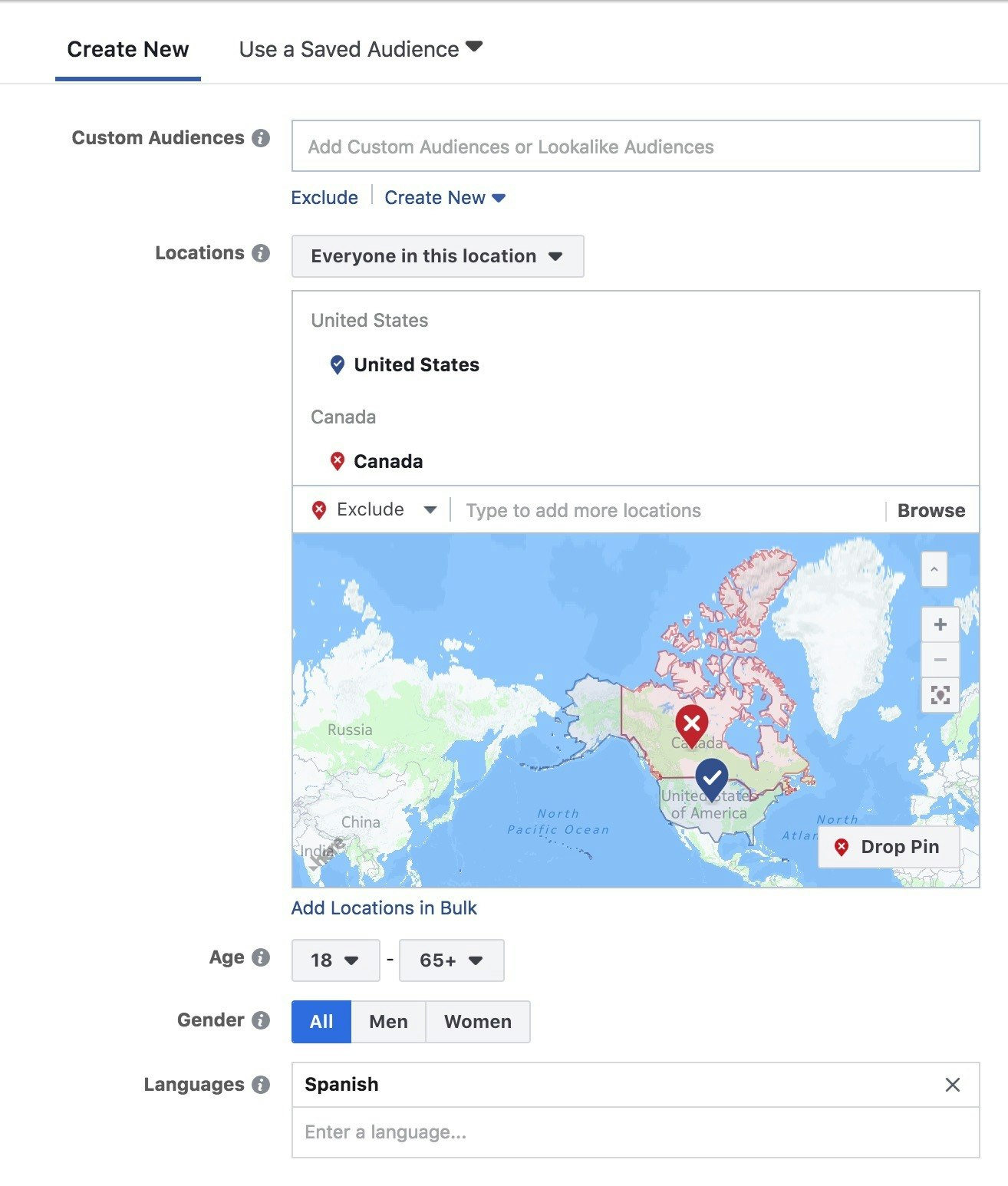
Facebook knows more than that, though, which means you can enhance your demographic targeting by merging it with psychographic segmentation.
Want to target people who are interested in beer? No problem. And what about certain types of beer – craft beer versus light beer? Also no problem.
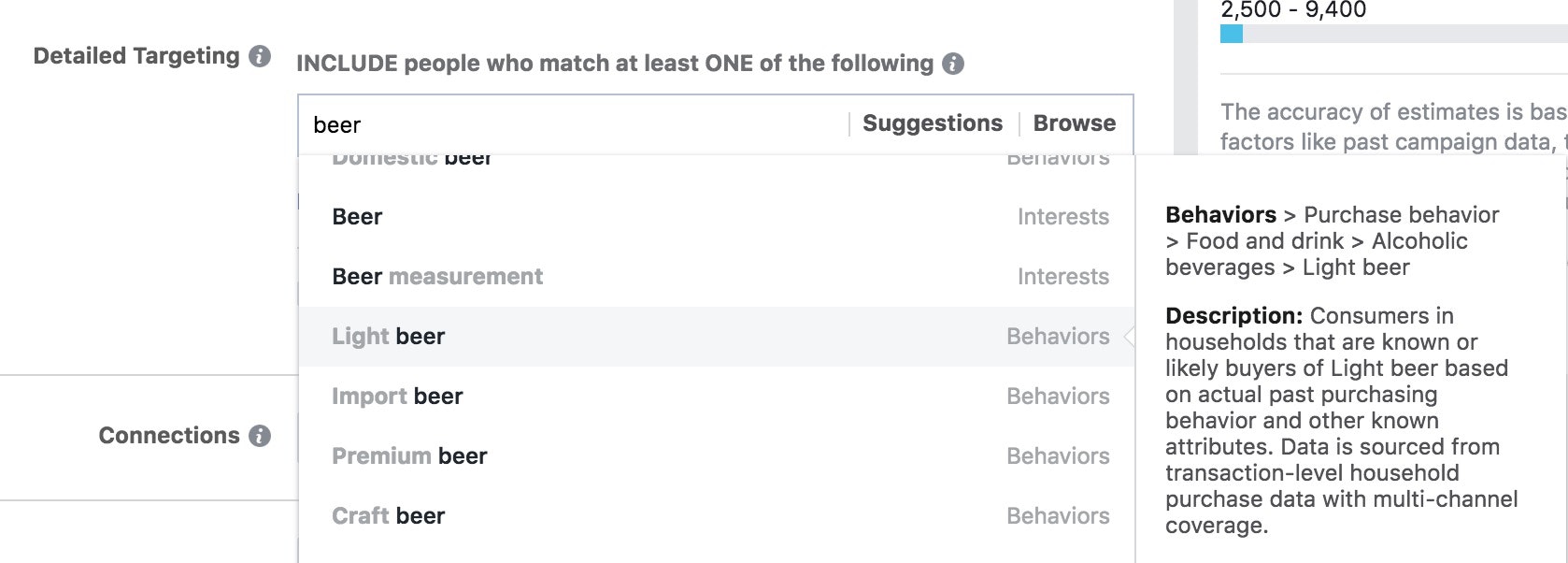
How does Facebook know who’s interested in certain types of beer? Hard to say. Could be the websites they visit, the events they checked in at, the pages they follow, and the posts they’ve liked.
Facebook will never give us the recipe to its psychographics sauce. But boy, do they have lots of info.
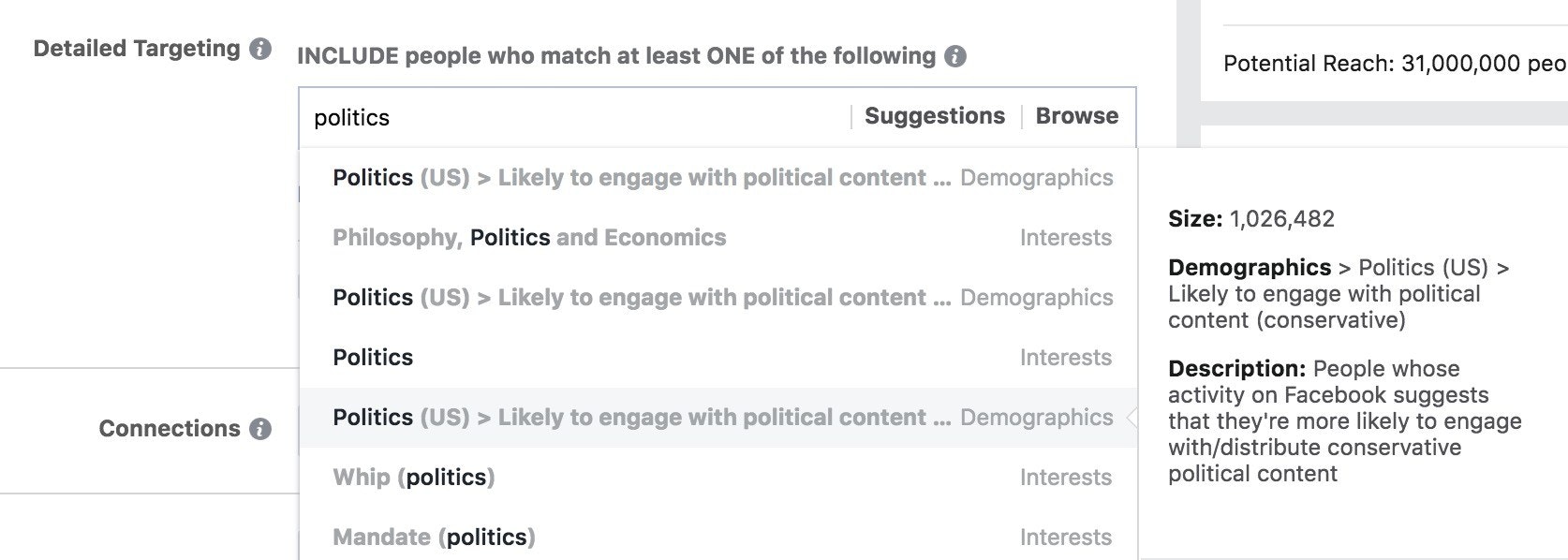
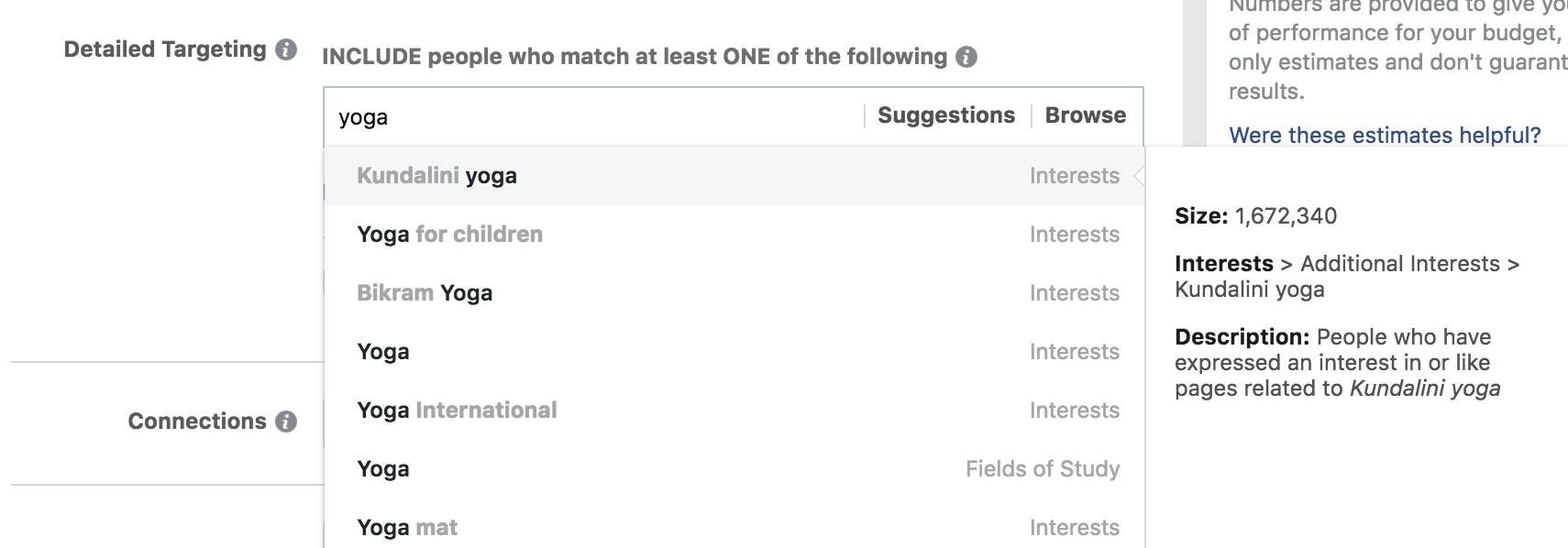
Facebook doesn’t own a monopoly on this sort of data. Google’s “audience targeting” inside of AdWords – which is where you set up campaigns across the Google suite of advertising services – lets you use the same sort of psychographic criteria as Facebook.
According to Google, adding audiences to an ad group or campaign allows you to reach potential customers based on their particular interests as they browse content, websites, channels, apps, and videos across YouTube and the GDN (Google Display Network). You can choose from a vast range of categories, including people shopping for vehicles, fans of sport and travel, and more.
This nugget about “across the Google Display Network and YouTube” is vital because it shows you how far Google’s psychographics tentacles reach: Someone watching loads of yoga videos is forking over valuable psychographic data.
Here is a very small sample of the interests that Google assigns to users – and the interests that marketers can use to create psychographic segments:


Also, you can filter on these interests in Google Analytics. Here you can see that we got only six page views the other week from people interested in Latin American Cuisine.

These are some psychographic segmentation examples. Once you have some data on people’s interests and preferences, you can use it to improve your brand image and targeting in your ad campaigns. Plus, you can create a more accurate customer journey when you truly understand what your customers need and desire.
Conclusions on Psychographics
Obtaining psychographic data is crucial, but the way you apply it to your marketing is how you make it effective. Ideally, you will craft your copy, images, and offers in such a way that they leverage the psychographic data at your fingertips. This will look different for different markets and niches.
Furthermore, remember that you can go way beyond targeting “American males between 20 and 30 years old.” In fact, you can merge those demographic factors with psychographic data that you think is consistent with your products, your brand, or both.
For example, if you cook up a great ad with a Star Trek joke, you could use one of the many Star Trek targeting filters inside Facebook:

Of course, you need to stay on the right side of copyright laws. But psychographic market segmentation from Facebook and Google gives you all sorts of avenues to create hyper-targeted ads. As a result, you have a higher chance of converting customers.
And conversion is something that we all like.






